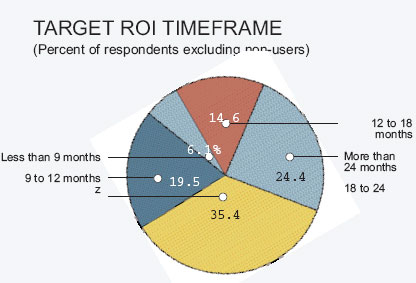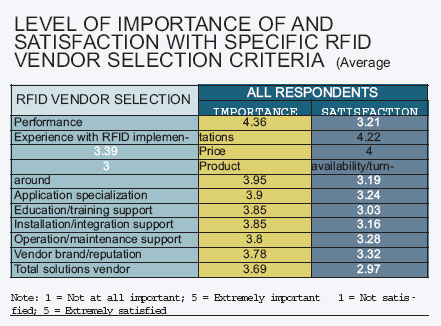Meeting Expectations
"Just 12 months ago, many manufacturers openly (or at least semi-privately) owned up to significant challenges in finding the ROI from RFID. This data shows that the thinking has evolved -- maybe not as fast as RFID advocates would like, but it's an evolution nonetheless. The good news is that most companies expect to see an ROI in the next 18 months. What's behind the shift? At the most basic level, more manufacturers now have a working knowledge of RFID, allowing them to see areas of process improvement and/or business transformation. It's also possible that the performance improvements of Gen 2 assuaged early adopter frustrations and corresponding pessimism. Still, a full 39 percent of manufacturers won't see an ROI in the next year and a half. The reasons for this are all over the map, which signals just how specific the business case is to each manufacturer, given each firm's unique product mix, distribution strategies and warehouse operations. And it means that, even thought things are looking up, a lot of work still needs to happen before RFID becomes a mainstream supply chain technology."

- Christine Overby, Forrester Research
[RFID Watch]
RFID in Retail
Here's a glimpse into how leading retailers' RFID projects are shaping up in 2006:
ALBERTSONS project scope: Case and pallet in Texas region; tagging by suppliers
Status: Bought by Supervalue; RFID pilot future unclear with merger activity required
BEST BUY project scope: Case and pallet tracking; tagging by suppliers
Status: Item-level tagging of video games; pilot extended to 50 stores; no immediate plans for further deployment; early results include improvements in sales and in-stocks
METRO project scope: Store of the future; case and pallet tagging; tracking by suppliers
Status: Live in Germany in specific divisions with first group of mandated suppliers; Rolling out implementation with more suppliers and stores
TARGET project scope: Case and pallet in Texas region; tagging by suppliers
Status: Up to 100 suppliers and 10 stores through the Tyler, Texas DC
TESCO project scope: Item-level tagging of DVDs to manage shelf availability
Status: Limitations in technology delayed item-level tagging; current plans include
cages and trolley tagging
WAL-MART project scope: Case and pallet tracking; tagging by suppliers;
class 2 narcotics at item level Status: 500 stores and five DCs; plans for 1,000 stores and 600 suppliers by 2007
Source: AMR Research, 2006

"Not surprisingly, performance had the highest satisfaction gap, consistent with what we see in the field. Even at today's relatively high RFID technology prices, the investment could be better justified in more process areas and product categories if the technology simply worked better. If, at even the most fundamental level, companies could rely on consistent read rates at or above 99 percent, today's prices would be more acceptable. Overall, the industry is still constrained by the equipment's inability to achieve a minimum level of performance. Minimum acceptable performance will trigger faster adoption in the highest value product categories, which will bring price down and drive the experience required to narrow the gap between importance and satisfaction. Without acceptable prices and performance improvement, this gap will likely linger. The raw satisfaction score on performance may be artificially high because there are relatively low expectations for today's RFID solutions. Most RFID users still do not rely on solutions to drive business transactions. If they did, we would see lower satisfaction scores for performance."
- Jeff Smith, Accenture
